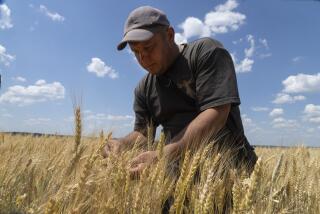COMMODITIES : Rumor of Big Sale to China Fuels Wheat Futures Jump
- Share via
Rumors that China was interested in buying more subsidized U.S. wheat sent futures prices sharply higher Tuesday on the Chicago Board of Trade.
The Agriculture Department announced after the close of trading that China was targeted for 1 million tons of export bonus wheat.
On other markets, cattle futures advanced the limit for daily trading and other livestock and meat contracts were higher, energy futures retreated and precious metals futures closed higher.
Wheat futures prices got off to a good start with support from stronger values of foreign currencies against the dollar and a report that Australia was reducing its projection for this season’s crop, said Jerry Gidel, an analyst in Chicago with G. H. Miller.
However, the big boost came when rumors began circulating that an announcement on China buying U.S. wheat was imminent, he said.
The government also announced after the close that Bulgaria was buying 150,000 tons each of wheat and barley.
The possibility of China taking subsidized wheat has been talked about in the market for the last week or so, said Dale Gustafson, an analyst with Drexel Burnham Lambert Inc. China already has taken 2 million tons of this year’s crop.
Wheat closed 3 cents to 6.5 cents higher with the contract for delivery in December at $2.9325 a bushel; corn was 1.25 cents to 3 cents higher with December at $1.86 a bushel; oats were 4.25 cents to 10 cents higher with December at $1.95 a bushel, and soybeans were 6 cents to 9.5 cents higher with November at $5.645 a bushel.
Cattle futures soared the 1.5 cents-a-pound limit for daily trading on the Chicago Mercantile Exchange, in response to a government report Monday that indicated tight supplies in the weeks ahead.
A seven-state cattle-on-feed report showed 11% more animals on feed as of Nov. 1 than a year earlier, just about what was expected. In addition, however, the report put marketings of cattle off the feed lot at 6% above last year, which was more than the trade generally expected.
“The marketing figure was definitely the catalyst,” said Phil Stanley, an analyst in Chicago with Thomson McKinnon Securities Inc.
“It was a real dynamite trade,” he said. “Not only was the marketing figure pretty positive, but the strong performance went a long way in providing some psychological support for the market.”
Cattle futures were knocked lower by the stock market crash and have been struggling to escape from the outside influences.
In addition to the report suggesting tight supplies on the feedlots, the possibility of bad weather as winter approaches could mean fewer animals getting to market, Stanley said.
More to Read
Inside the business of entertainment
The Wide Shot brings you news, analysis and insights on everything from streaming wars to production — and what it all means for the future.
You may occasionally receive promotional content from the Los Angeles Times.










